aom
Accessibility Object Model
Authors:
- Alice Boxhall, Google, aboxhall@google.com
- James Craig, Apple, jcraig@apple.com
- Dominic Mazzoni, Google, dmazzoni@google.com
- Alexander Surkov, Mozilla, surkov.alexander@gmail.com
Table of Contents
- Introduction
- Motivating use cases
- The Accessibility Object Model
- Reflecting ARIA attributes
- Reflecting Element references
- Default semantics for Custom Elements via the
ElementInternalsobject - Shipping, Needs Testing: User action events from Assistive Technology
- Abandoned: New InputEvent types
- Speculative, Blocked: Virtual Accessibility Nodes
- Full Introspection of an Accessibility Tree
- Audience for the proposed API
- What happened to
AccessibleNode?
- Next Steps
- Additional thanks
- Appendices
- Background: assistive technology and the accessibility tree
- Background: DOM tree, accessibility tree and platform accessibility APIs
- Abandoned: Appendix:
AccessibleNodenaming - Abandoned: Appendix: Partial proposed IDL for virtual accessibility nodes
- Abandoned: Appendix: partial proposed IDL for
ComputedAccessibleNode
Introduction
This effort aims to develop additions to the web platform to allow developers to provide information to assistive technology APIs, and to understand what information browsers provide to those APIs.
Motivating use cases
(More background on existing APIs can be found in the Appendices.)
Web apps that push the boundaries of what’s possible on the web struggle to make them accessible because the APIs aren’t yet sufficient - in particular, they are much less expressive than the native APIs that the browser communicates with.
- Setting non-reflected (“default”) accessibility properties for Web Components which can be overridden by page authors
- Currently, Web Components are forced to use ARIA to declare their default semantics. This causes ARIA attributes which are really implementation details to “leak” into the DOM.
- This capability need not, but may be limited to Web Components.
- Setting relationship properties without needing to use IDREFs
- Currently, to specify any ARIA relationship, an author must specify a unique ID on any element which may be the target of the relationship.
- In the case of something like
aria-activedescendant, this may be one of hundreds or thousands of elements, depending on the UI. This requirement makes these APIs cumbersome to use and lead to many extra DOM attributes being necessary.
- Listening for events from Assistive Technology
- Currently, only built-in elements have the capability to react to events, typically triggered by user actions such as “increment”.
- Adding non-DOM nodes (“virtual nodes”) to the Accessibility tree
- For example, to express a complex UI built out of a
<canvas>element, or streaming a remote desktop to a<video>element, etc. - These should be able to express at least the same set of accessible properties as Elements, as well as parent/child/other relationships with other virtual nodes, and position/dimensions.
- For example, to express a complex UI built out of a
- Introspecting the computed accessibility tree and interpreted accessibility attributes/properties
- Developers currently have no way to probe or test how ARIA and other accessible properties are applied.
- Browser implementers have no API to automate comparison testing of engine accessibilty internals for interoperability.
The Accessibility Object Model
The Accessibility Object Model (AOM) is a set of changes to HTML and related standards to address the use cases above.
(Note: If you were familiar with an earlier version of AOM,
you might be wondering what happened to AccessibleNode?)
Reflecting ARIA attributes
See ARIA Reflection Explainer.
Default semantics for Custom Elements via the ElementInternals object
We propose that Custom Element authors be able to provide default semantics
via the ElementInternals object.
A custom element author may use the ElementInternals object
to modify the semantic state of an instance of a custom element
in response to user interaction.
The properties set on the ElementInternals object
are used when mapping the element to an accessible object.
If the author-provided semantics conflict with the Custom Element semantics, the author-provided semantics take precedence.
Note: this is analogous to setting an “instance variable” - a copy of these semantic properties is created for each instance of the custom element. The semantics defined in each apply only to their associated custom element instance object.
Use case 1: Setting non-reflected (“default”) accessibility properties for Web Components
Today, a library author creating a Web Component is forced to “sprout” ARIA attributes to express semantics which are implicit for native elements.
<!-- Page author uses the custom elements as they would native elements -->
<custom-tablist>
<custom-tab selected>Tab 1</custom-tab>
<custom-tab>Tab 2</custom-tab>
<custom-tab>Tab 3</custom-tab>
</custom-tablist>
<!-- Custom elements are forced to "sprout" extra attributes to express semantics -->
<custom-tablist role="tablist">
<custom-tab
selected
role="tab"
aria-selected="true"
aria-controls="tabpanel-1"
>Tab 1</custom-tab
>
<custom-tab role="tab" aria-controls="tabpanel-2">Tab 2</custom-tab>
<custom-tab role="tab" aria-controls="tabpanel-3">Tab 3</custom-tab>
</custom-tablist>
Using ElementInternals to set the default semantics,
a Custom Element may avoid needing to sprout attributes,
and also avoid losing its semantics if authors decide to delete ARIA attributes.
class CustomTab extends HTMLElement {
constructor() {
super();
this._internals = customElements.createInternals(this);
this._internals.role = "tab";
}
// Observe the custom "active" attribute.
static get observedAttributes() {
return ["active"];
}
connectedCallback() {
this._tablist = this.parentElement;
}
setTabPanel(tabpanel) {
if (tabpanel.localName !== "custom-tabpanel" || tabPanel.id === "") return; // fail silently
this._tabpanel = tabpanel;
tabpanel.setTab(this);
this._internals.ariaControls = tabPanel; // does not reflect
}
// ... setters/getters for custom properties which reflect to attributes
attributeChangedCallback(name, oldValue, newValue) {
switch (name) {
case "active":
let active = newValue != null;
this._tabpanel.shown = active;
// When the custom "active" attribute changes,
// keep the accessible "selected" state in sync.
this._internals.ariaSelected = newValue !== null;
if (selected) this._tablist.setSelectedTab(this); // ensure no other tab has "active" set
break;
}
}
}
customElements.define("custom-tab", CustomTab);
Authors using these elements may override the default semantics using ARIA attributes as normal.
For example, an author may modify the appearance
of a <custom-tablist> element to appear as a vertical list.
They could add an aria-orientation attribute to indicate this,
overriding the default semantics set in the custom element implementation.
class CustomTabList extends HTMLElement {
constructor() {
super();
this._internals = customElements.createInternals(this);
this._internals.role = "tablist";
this._internals.ariaOrientation = "horizontal";
}
// ...
}
customElements.define("custom-tablist", CustomTabList);
<custom-tablist aria-orientation="vertical" class="vertical-tablist">
<custom-tab selected>Tab 1</custom-tab>
<custom-tab>Tab 2</custom-tab>
<custom-tab>Tab 3</custom-tab>
</custom-tablist>
Spec/implementation status
- There is an open PR on the WHATWG HTML spec.
- This is currently being implemented in Blink.
User action events from Assistive Technology
(Partially Shipping, Needs Testing)
To preserve the privacy of assistive technology users, events from assistive technology will typically cause a synthesised DOM event to be triggered. The events are determined by platform conventions and partially documented in the ARIA Authoring Practices Guide (APG).
| AT event | Targets | Orientation/Direction | DOM event |
|---|---|---|---|
click or press |
all elements | click MouseEvent¹ |
|
focus |
all focusable elements | focus Event |
|
blur |
No targets, as blur could potentially ‘out’ AT users. |
None | |
select |
Elements whose computed role supports aria-selected |
click MouseEvent¹ |
|
contextMenu |
all elements | contextmenu MouseEvent² |
|
dismiss or escape |
all elements | Escape KeyboardEvent³ |
|
increment |
Elements w/ computed role scrollbar, or slider |
vertical | Up KeyboardEvent³ |
| ”” | horizontal LTR | Right KeyboardEvent³ |
|
| ”” | horizontal RTL | Left KeyboardEvent³ |
|
Elements w/ computed role spinbutton |
orientation n/a | Up KeyboardEvent³ |
|
decrement |
Elements w/ computed role scrollbar or slider |
vertical | Down KeyboardEvent³ |
| ”” | horizontal LTR | Left KeyboardEvent³ |
|
| ”” | horizontal RTL | Right KeyboardEvent³ |
|
Elements w/ computed role spinbutton |
orientation n/a | Down KeyboardEvent³ |
|
scrollByPage |
TBD (possibly custom scroll views) | TBD (possibly PageUp/PageDown) |
|
scrollIntoView |
TBD | No equivalent DOM event | |
setValue |
n/a | No equivalent DOM event |
Notes on the previous table:
- ¹
clicksequences includemousedown/mouseupandtouchstart/touchendwhere relevant. - ²
contextmenusequences may need to include MouseEvents, includingmousedown/mouseup/auxclick/contextmenu. - ³ DOM KeyboardEvent sequences include
keyup/keydown. - Control orientation is determined by the computed value of
aria-orientationwhich defaults tohorizontalforslider, and defaults toverticalforscrollbar. - Natural language direction is determined by the computed value of
dirwhich usualy computes to toltr(autoin most contexts resolves toltr), but can be set tortlfor languages such as Arabic and Hebrew. - The DOM event target for DOM KeyboardEvent sequences is the currently focused DOM element, regardless if the AT’s “point of regard” matches the document.activeElement.
- If a web author does not cancel the DOM event with
Event.preventDefault()and/orEvent.stopPropagation(), the DOM event should propagate out of the web view an potentially trigger the platform behavior of the assistive technology event. For example, if an iOS user triggers a native dismiss/escape event but the web author does not capture or cancel the DOM Escape key sequence, the browser or system should execute the default functionality of the nativeaccessibilityPerformEscape()handler.
MouseEvent Object Properties
| MouseEvent | button |
target/srcElement |
which (deprecated) |
|---|---|---|---|
| click | 1 | TBD | 1 |
| contextmenu | 2 (secondary click) | TBD | 3 (legacy right click) |
Note: Only send the deprecated which property if the user agent would normally send it on a non-synthesized mouse event.
Note: The target and srcElement properties should match the most likely element in the case of a non-synthesized MouseEvent (a real mouse click). Since AT focus targets and pointer event targets do not always align one-to-one, this event property is currently TBD. For example, users agents might attempt to synthesize a pointer event x/y position near the center of the element in AT focus. If hit-testing at that x/y position does not return a descendant of the element in AT focus, user agents might synthesize the event on the element directly in AT focus.
KeyboardEvent Object Properties
| KeyEvent | key |
code |
location |
target/srcElement |
|---|---|---|---|---|
| Escape | “Escape” | “Escape” | DOM_KEY_LOCATION_STANDARD (0) | document.activeElement |
| Left | “ArrowLeft” | “ArrowLeft” | DOM_KEY_LOCATION_STANDARD (0) | document.activeElement |
| Up | “ArrowUp” | “ArrowUp” | DOM_KEY_LOCATION_STANDARD (0) | document.activeElement |
| Right | “ArrowRight” | “ArrowRight” | DOM_KEY_LOCATION_STANDARD (0) | document.activeElement |
| Down | “ArrowDown” | “ArrowDown” | DOM_KEY_LOCATION_STANDARD (0) | document.activeElement |
The target and srcElement properties should match document.activeElement, which is either the currently focused element or document.body.
Deprecated KeyboardEvent Object Properties (Optional)
Only send these deprecated properties if the user agent would normally send them on non-synthesized keyboard events.
| KeyEvent | charCode |
keyCode |
keyIdentifier |
keyLocation |
which |
|---|---|---|---|---|---|
| Escape | 0 | 27 | U+001B (Unicode Character ‘ESCAPE’) | 0 | 27 |
| Left | 0 | 37 | Left |
0 | 37 |
| Up | 0 | 38 | Up |
0 | 38 |
| Right | 0 | 39 | Right |
0 | 39 |
| Down | 0 | 40 | Down |
0 | 40 |
Note: These event property tables are intended to assist implementors during the incubation process. This is not intended as a normative specification.
Abandoned: New InputEvent types
Note: This section is abandoned, as there is now no immediate plan to include InputEvents for Assistive Technology Actions.
We considered also adding some new InputEvent types:
incrementdecrementdismissscrollPageUpscrollPageDown
These could have been be triggered via assistive technology events, along with the synthesised keyboard events listed in the above table, and also synthesised when the keyboard events listed above occur in the context of a valid target for the corresponding assistive technology event.
For example,
if a user not using assistive technology presses the Escape key in any context,
an input event with a type of dismiss will be fired at the focused element
along with the keypress sequence.
If the same user pressed Up while page focus was on
a <input type="range"> or an element with a role of slider
(either of which will have a computed role of slider),
an input event with a type of increment will be fired at the focused element
along with the keypress sequence.
Abandoned Use case 3: Listening for events from Assistive Technology
Note: This section is abandoned, as there is now no immediate plan to implement specific, direct events from Assistive Technology, but see earlier section, User action events from Assistive Technology for indirect events.
For example:
- A user may be using voice control software and they may speak the name of a button somewhere in a web page. The voice control software finds the button matching that name in the accessibility tree and sends an action to the browser to click on that button.
- That same user may then issue a voice command to scroll down by one page. The voice control software finds the root element for the web page and sends it the scroll action.
- A mobile screen reader user may navigate to a slider, then perform a gesture to increment a range-based control. The screen reader sends the browser an increment action on the slider element in the accessibility tree.
Currently, browsers implement partial support for accessible actions
either by implementing built-in support for native HTML elements
(for example, a native HTML <input type="range">
already supports increment and decrement actions,
and text boxes already support actions to set the value or insert text).
However, there is no way for web authors to listen to accessible actions on
custom elements.
For example, the
custom slider above with a role of slider
prompts a suggestion on VoiceOver for iOS
to perform swipe gestures to increment or decrement,
but there is no way to handle that semantic event via any web API.
Developers will be able to listen for keyboard events or input events to capture that semantic event.
For example, to implement a custom slider,
the author could handle the Up and Down key events
as recommended in the ARIA Authoring Practices guide,
and this would handle the assistive technology event as well.
customSlider.addEventListener('keydown', (event) => {
switch (event.code) {
case "ArrowUp":
customSlider.value += 1;
return;
case "ArrowDown":
customSlider.value -= 1;
return;
});
Spec/implementation status
Not yet specced or implemented anywhere.
Speculative, Blocked: Virtual Accessibility Nodes
Important note: At this point, due to a number of complications including privacy concerns, the working group is not pursuing virtual nodes as intended. Instead, the goal is to focus on alternate solutions to valid use-cases.
See: https://github.com/w3ctag/design-principles/issues/293
Original idea: Virtual Accessibility Nodes would allow authors to expose “virtual” accessibility nodes, which are not associated directly with any particular DOM element, to assistive technology.
This mechanism is often present in native accessibility APIs, in order to allow authors more granular control over the accessibility of custom-drawn APIs.
How it could look:
- Calling
attachAccessibleRoot()causes anAccessibleNodeto be associated with aNode.- The returned
AccessibleNodeforms the root of a virtual accessibility tree. - The Node’s DOM children are implicitly ignored for accessibility once an
AccessibleRootis attached - there is no mixing of DOM children and virtual accessible nodes.
- The returned
- Like
ShadowRoot, an element may only have one associatedAccessibleRoot. - Only
AccessibleNodes may haveAccessibleNodesas children, andAccessibleNodes may only haveAccessibleNodes as children.
(Again, the current plan is to try to solve use cases without virtual nodes.)
Use case 4: Custom-drawn UI
The most common example expressed is canvas-based UI, but there are several ways that a web app might have custom-drawn UI:
- Canvas with a 2D context
- Canvas with a WebGL context
- SVG
- HTML elements that are used as raw building blocks rather than semantic groupings
- The video element, perhaps the UI is rendered on a remote server and streamed
The challenge is that when the UI is custom-drawn, there aren’t any DOM elements to add ARIA attributes to in order to make it accessible.
The original idea was to use virtual nodes as a solution - create nodes specifically for accessibility, for example:
// Implementing a canvas-based spreadsheet's semantics
canvas.attachAccessibleRoot();
let table = canvas.accessibleRoot.appendChild(new AccessibleNode());
table.role = "table";
table.colCount = 10;
table.rowcount = 100;
let headerRow = table.appendChild(new AccessibleNode());
headerRow.role = "row";
headerRow.rowindex = 0;
// etc. etc.
Virtual nodes would typically need to have location and dimensions set explicitly:
cell.offsetLeft = "30px";
cell.offsetTop = "20px";
cell.offsetWidth = "400px";
cell.offsetHeight = "300px";
cell.offsetParent = table;
If offsetParent is left unset, the coordinates are interpreted relative to the accessible node’s parent.
To make a node focusable, the focusable attribute can be set.
This is similar to setting tabIndex=-1 on a DOM element.
virtualNode.focusable = true;
Virtual accessible nodes are not focusable by default.
Finally, to focus an accessible node, call its focus() method.
virtualNode.focus();
When a virtual accessible node is focused, input focus in the DOM is unchanged. The focused accessible node is reported to assistive technology and other accessibility API clients, but no DOM events are fired and document.activeElement is unchanged.
When the focused DOM element changes, accessible focus follows it: the DOM element’s associated accessible node gets focused.
Privacy concerns
One of the biggest concerns around this proposal is that any events fired on virtual nodes would be an immediate indication that the user must be using assistive technology, which is private information that the user may not want to reveal.
Adding a permission dialog might help if virtual nodes were only truly needed on a small number of specialized websites, but that would preclude their use in any widget library.
See: https://github.com/w3ctag/design-principles/issues/293
Current thinking
To avoid privacy concerns, the most likely path forwards for custom-drawn UI will be to promote the use of true DOM elements as fallback content, with efforts to address weaknesses in this approach, such as:
- Addressing performance issues, perhaps by making it easier to avoid layout for fallback nodes
- New ARIA attributes to allow specifying the accessible bounding box of a node
- New ARIA attributes to decouple the node that has input focus, from the node that is exposed as focused to assistive technology
- New ARIA attributes to make it possible to build a fully custom text editing control
Spec/implementation status
Not yet specced or implemented anywhere.
Full Introspection of an Accessibility Tree
This functionality is still being considered as part of Issue #197 but it is highly unlikely to land in a format similar to the API proposed below.
It may be approached initially as a testing-only API.
Use case 5: Introspecting the computed accessibility tree and interpreted accessibility attributes/properties
The Computed Accessibility Tree API will allow authors to access the full computed accessibility tree - all computed properties for the accessibility node associated with each DOM element, plus the ability to walk the computed tree structure.
This could make it possible to:
- write a programmatic interoperability test which asserts anything about the semantic properties of an element or a page.
- build a reliable browser-based assistive technology - for example, a browser extension which uses the accessibility tree to implement a screen reader, screen magnifier, or other assistive functionality; or an in-page tool.
- detect whether an accessibility property has been successfully applied (via ARIA or otherwise) to an element - for example, to detect whether a browser has implemented a particular version of ARIA.
- perform debugging/checking of accessibility tree issues.
- react to accessibility tree state, for example, detecting the exposed role of an element and modifying the accessible help text to suit.
Spec/implementation status
WebDriver (Shipping in WebKit/Chromium/Gecko)
- computedrole
- computedlabel
- Some discussion of getting a backing accessibility reference (and parent/children) for tree access
WPT TestDriver (functional as of March 2023)
Leverages WebDriver accessors for ease of test development.
Legacy and abondoned implementations
A purely experimental implementation exists in Blink,
via the command-line flag --enable-blink-features="AccessibilityObjectModel".
This adds a method to Window, getComputedAccessibleNode(node),
which returns the computed accessible properties for the given node.
This implementation is not reliable and may be removed at any point.
The similar experimental implementation in WebKit is scheduled to be removed.
Why is accessing the computed properties being addressed last?
Consistency Currently, the accessibility tree is not standardized between browsers: Each implements accessibility tree computation slightly differently. In order for this API to be useful, it needs to work consistently across browsers, so that developers don’t need to write special case code for each.
We want to take the appropriate time to ensure we can agree on the details for how the tree should be computed and represented.
Performance Computing the value of many accessible properties requires layout. Allowing web authors to query the computed value of an accessible property synchronously via a simple property access would introduce confusing performance bottlenecks.
We will likely want to create an asynchronous mechanism for this reason,
meaning that it will not be part of the accessibleNode interface.
User experience Compared to the previous three phases, accessing the computed accessibility tree will have the least direct impact on users. In the spirit of the Priority of Constituencies, it makes sense to tackle this work last.
Audience for the proposed API
This API is will be primarily of interest to the relatively small number of developers who create and maintain the JavaScript frameworks and widget libraries that power the vast majority of web apps. Accessibility is a key goal of most of these frameworks and libraries, as they need to be usable in as broad a variety of contexts as possible. A low-level API would allow them to work around bugs and limitations and provide a clean high-level interface that “just works” for the developers who use their components.
This API is also aimed at developers of large flagship web apps that push the boundaries of the web platform. These apps tend to have large development teams who look for unique opportunities to improve performance using low-level APIs like Canvas. These development teams have the resources to make accessibility a priority too, but existing APIs make it very cumbersome.
What happened to AccessibleNode?
Initially, our intention was to combine these use cases into a read/write API
analogous to the DOM,
wherein each DOM Element would have an associated AccessibleNode
allowing authors to read and write accessible properties.
This was named the Accessibility Object Model,
analogous to the Document Object Model.
However, as discussions progressed it became clear that there were some issues with this model:
- Computing the accessibility tree should not be necessary in order to modify it -
getting an
AccessibleNodeto write to should thus not depend on getting the computed properties. - Exposing the computed accessibility tree requires standardisation across browsers of how the tree is computed.
- If we are not exposing computed properties on an
Element’sAccessibleNode, it’s unclear what the purpose of this object is beyond a “bag of properties”. - Determining the order of precedence of ARIA properties
and
AccessibleNodeproperties did not have an obvious “correct” answer. - Similarly, using exclusively
AccessibleNodes to express relationships was confusing.
These issues prompted a reassessment, and a simplification of the API based around the original set of use cases we were committed to addressing.
[Update: April 2023] Similar functionality is being reconsidered as a test-only API in Issue #197
Next Steps
The Accessibility Object Model development is led by a team of editors that represent several major browser vendors.
Issues can be filed on GitHub:
https://github.com/WICG/aom/issues
Incubation
We intend to continue development of this spec as part of the Web Platform Incubator Community Group (WICG). Over time it may move into its own community group.
Our intent is for this group’s work to be almost entirely orthogonal to the current work of the Web Accessibility Initiative groups such as ARIA. While ARIA defines structural markup and semantics for accessibility properties on the web, often requiring coordination with assistive technology vendors and native platform APIs, the AOM simply provides a parallel JavaScript API that provides more low-level control for developers and fills in gaps in the web platform, but without introducing any new semantics.
Additional thanks
Many thanks for valuable feedback, advice, and tools from:
- Alex Russell
- Anne van Kesteren
- Bogdan Brinza
- Chris Fleizach
- Chris Hall
- Cynthia Shelley
- David Bolter
- Domenic Denicola
- Elliott Sprehn
- Ian Hickson
- Joanmarie Diggs
- Marcos Caceres
- Meredith Lane
- Nan Wang
- Robin Berjon
- Rossen Atanassov
- Ryosuke Niwa
- Tess O’Connor
Bogdan Brinza and Cynthia Shelley of Microsoft were credited as authors of an earlier draft of this spec but are no longer actively participating.
Appendices
Background: assistive technology and the accessibility tree
Assistive technology, in this context, refers to a third party application which augments or replaces the existing UI for an application. One well-known example is a screen reader, which replaces the visual UI and pointer-based UI with an auditory output (speech and tones) and a keyboard and/or gesture-based input mechanism.
Many assistive technologies interact with a web page via accessibility APIs, such as UIAutomation on Windows, or NSAccessibility on OS X. These APIs allow an application to expose a tree of objects representing the application’s interface, typically with the root node representing the application window, with various levels of grouping node descendants down to individual interactive elements. This is referred to as the accessibility tree.
An assistive technology user interacts with the application almost exclusively via this API, as the assistive technology uses it both to create the alternative interface, and to route user interaction events triggered by the user’s commands to the assistive technology.
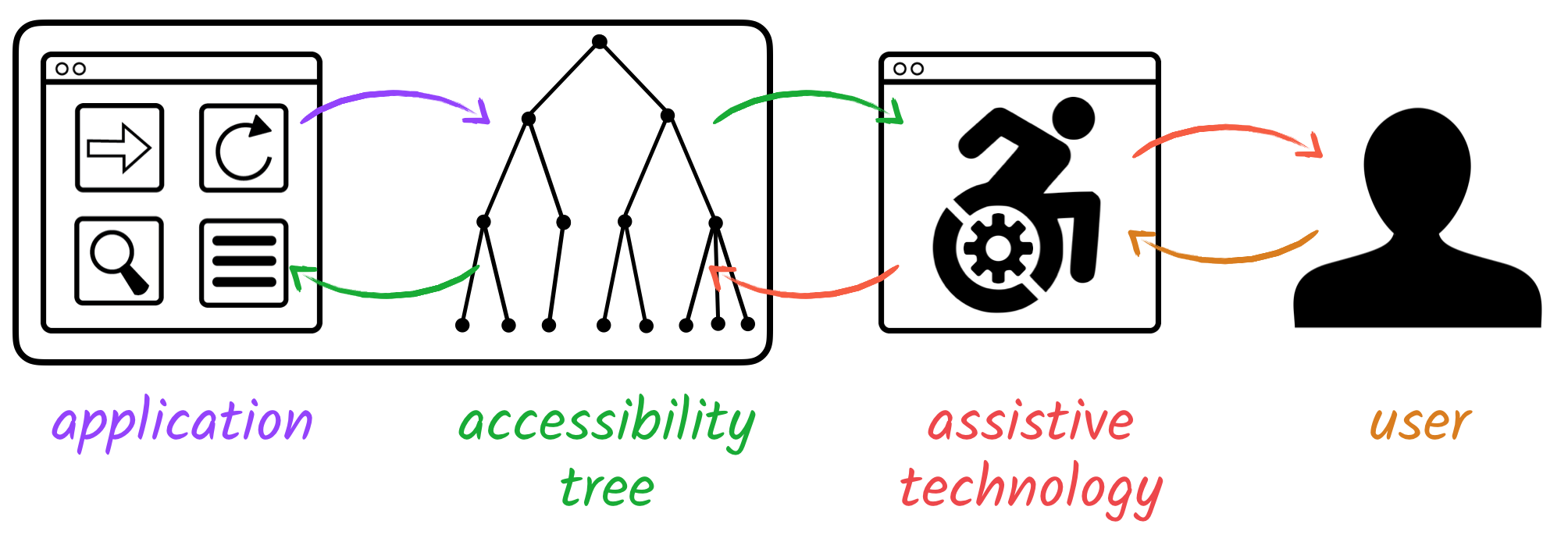
Both the alternative interface’s output (e.g. speech and tones, updating a braille display, moving a screen magnifier’s focus) and input (e.g. keyboard shortcuts, gestures, braille routing keys, switch devices, voice input) are completely the responsibility of the assistive technology, and are abstracted away from the application.
For example, a VoiceOver user interacting with a native application on OS X might press the key combination “Control Option Spacebar” to indicate that they wish to click the UI element which the screen reader is currently visiting.
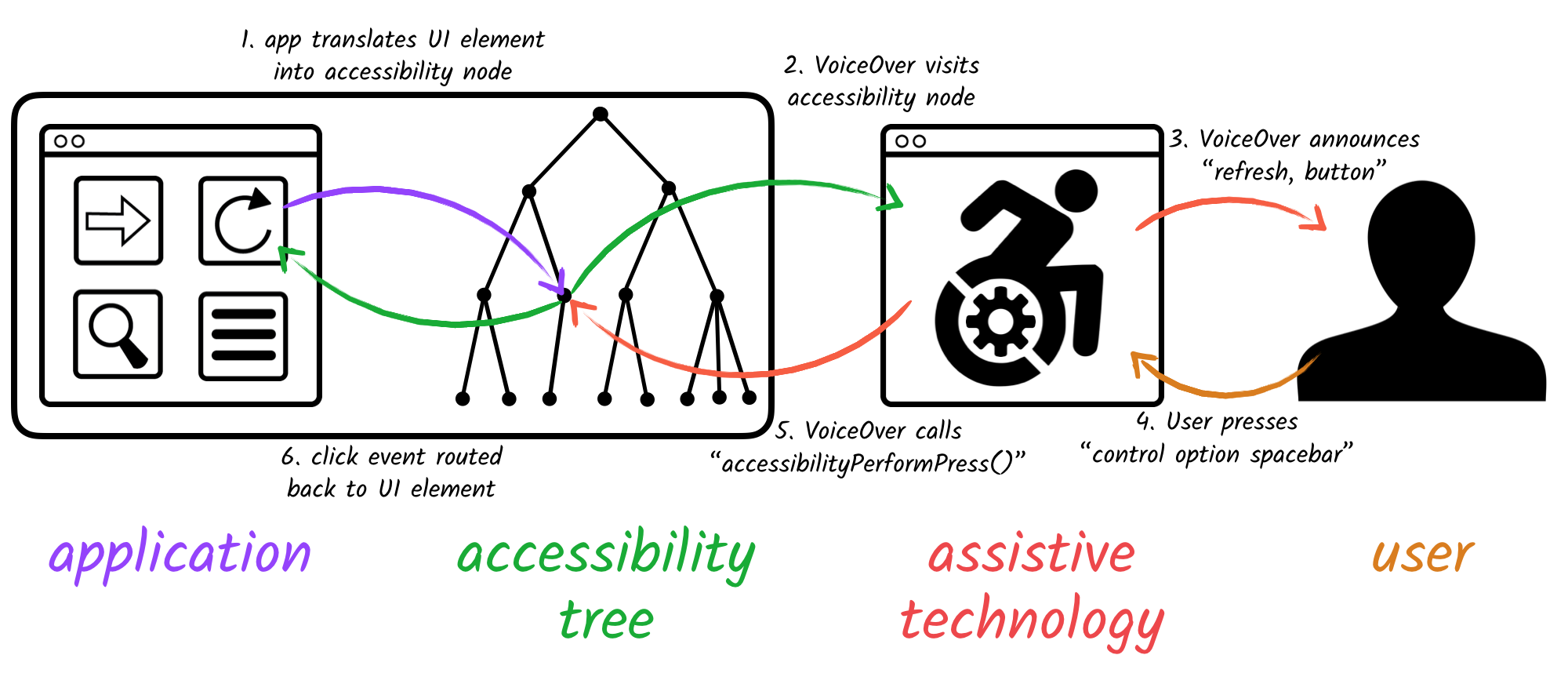
These keypresses would never be passed to the application,
but would be interpreted by the screen reader,
which would then call the
accessibilityPerformPress()
function on the accessibility node representing the UI element in question.
The application can then handle the press action;
typically, this routes to the code which would handle a click event.
Accessibility APIs are also popular for testing and automation. They provide a way to examine an application’s state and manipulate its UI from out-of-process, in a robust and comprehensive way. While assistive technology for users with disabilities is typically the primary motivator for accessibility APIs, it’s important to understand that these APIs are quite general and have many other uses.
Accessibility node properties
Each node in the accessibility tree may be referred to as an accessibility node.
An accessibility node always has a role, indicating its semantic purpose.
This may be a grouping role,
indicating that this node merely exists to contain and group other nodes,
or it may be an interactive role,
such as "button".
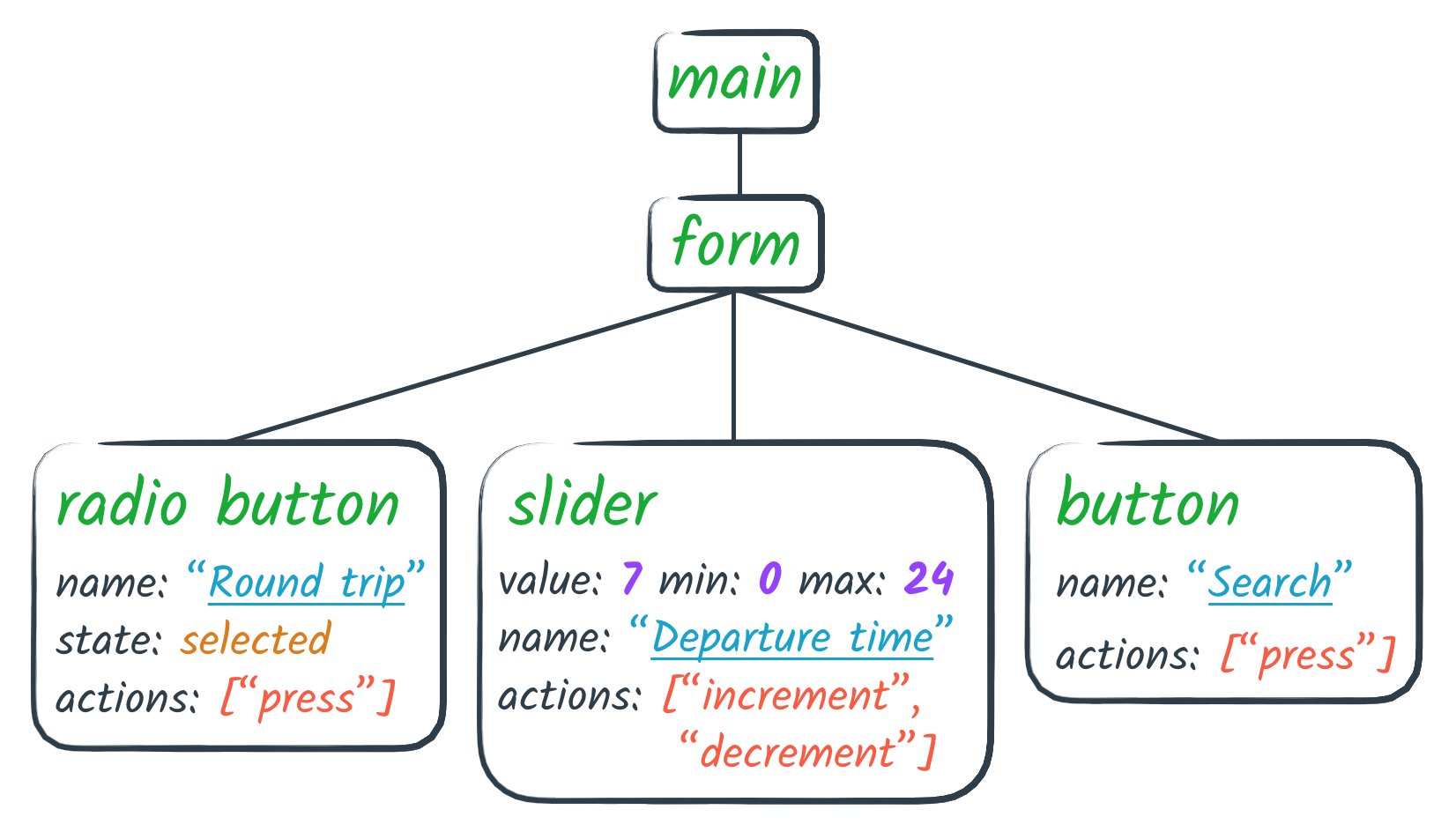
The user, via assistive technology, may explore the accessibility tree at various levels. They may interact with grouping nodes, such as a landmark element which helps a user navigate sections of the page, or they may interact with interactive nodes, such as a button. In both of these cases, the node will usually need to have a label (often referred to as a name) to indicate the node’s purpose in context. For example, a button may have a label of “Ok” or “Menu”.
Accessibility nodes may also have other properties,
such as the current value
(e.g. "10" for a range, or "Jane" for a text input),
or state information
(e.g. "checked" for a checkbox, or "focused").
Interactive accessibility nodes may also have certain actions which may be performed on them.
For example, a button may expose a "press" action, and a slider may expose
"increment" and "decrement" actions.
These properties and actions are referred to as the semantics of a node. Each accessibility API expresses these concepts slightly differently, but they are all conceptually similar.
Background: DOM tree, accessibility tree and platform accessibility APIs
The web has rich support for making applications accessible, but only via a declarative API.
The DOM tree is translated, in parallel, into the primary, visual representation of the page, and the accessibility tree, which is in turn accessed via one or more platform-specific accessibility APIs.
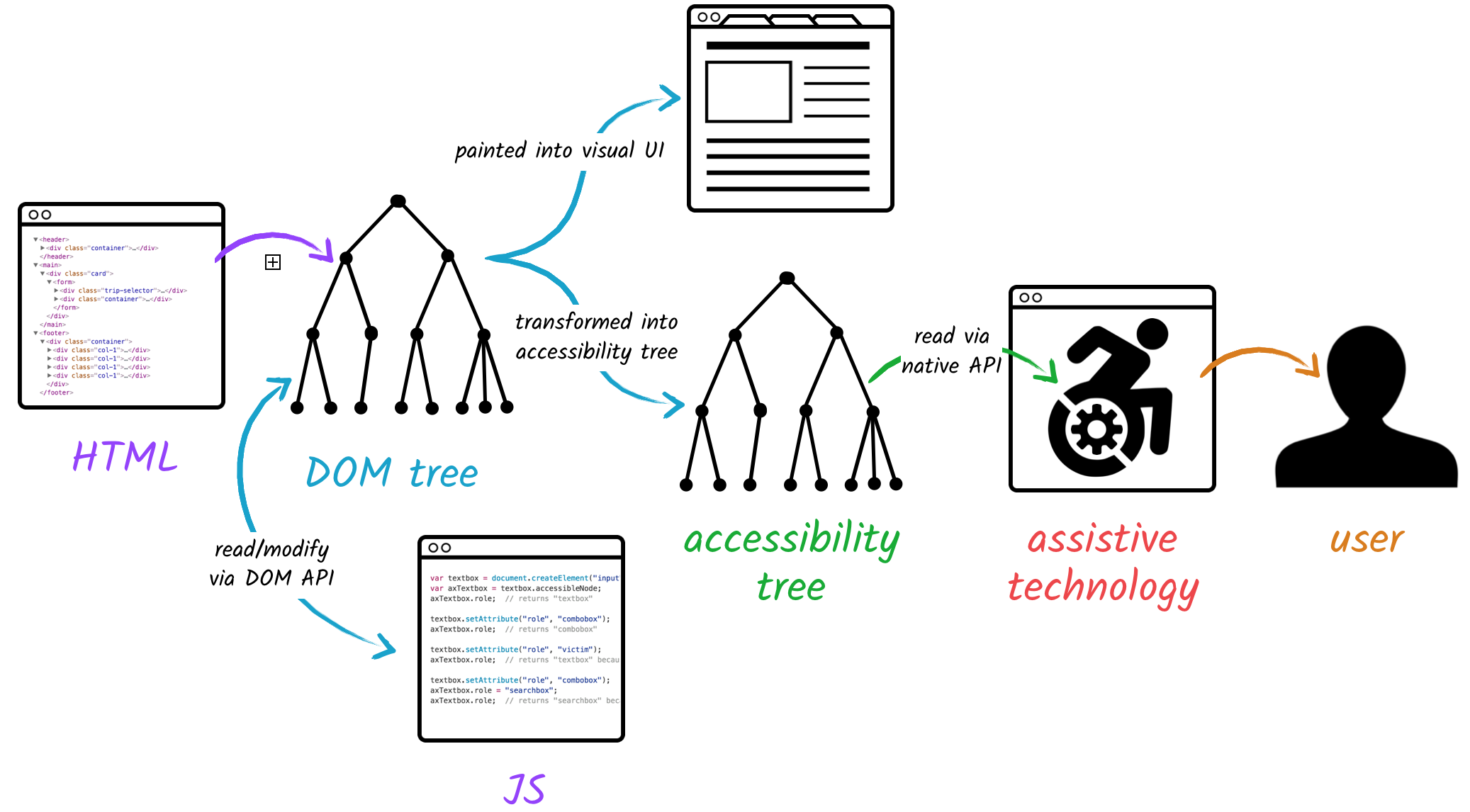
Some browsers support multiple accessibility APIs across different platforms, while others are specific to one accessibility API. However, any browser that supports at least one native accessibility API has some mechanism for exposing a tree structure of semantic information. We refer to that mechanism, regardless of implementation details, as the accessibility tree for the purposes of this API.
Mapping native HTML to the accessibility tree
Native HTML elements are implicitly mapped to accessibility APIs.
For example, an <img> element will automatically be mapped
to an accessibility node with a role of "image"
and a label based on the alt attribute (if present).
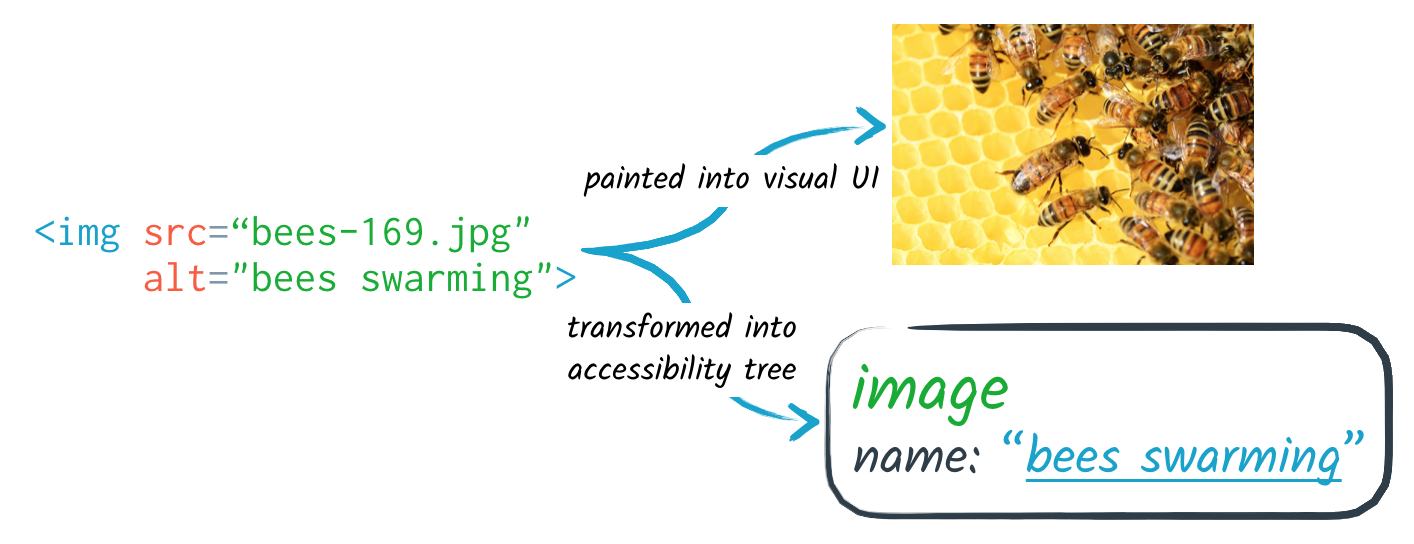
ARIA
Alternatively, ARIA allows developers to annotate elements with attributes to override the default role and semantic properties of an element - but not to expose any accessible actions.
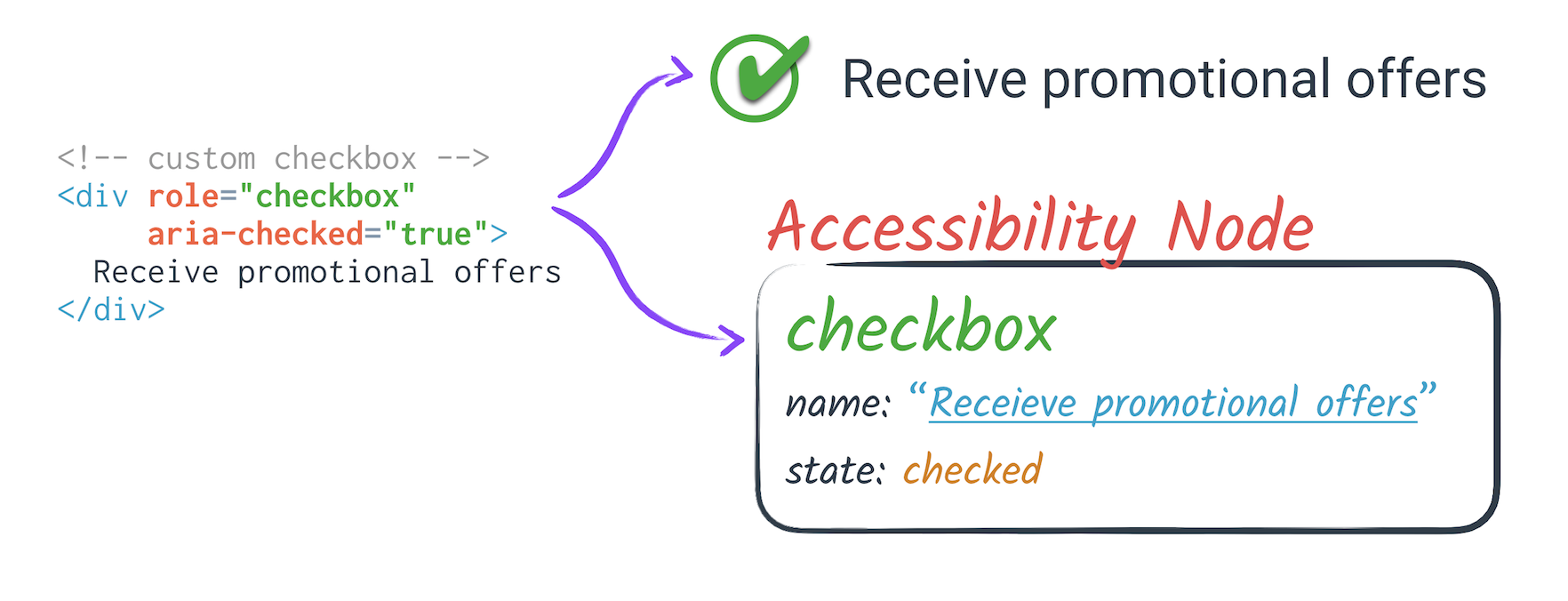
In either case there’s a one-to-one correspondence between a DOM node and a node in the accessibility tree, and there is minimal fine-grained control over the semantics of the corresponding accessibility node.
Appendix: AccessibleNode naming
We have chosen the name AccessibleNode for the class representing one
node in the virtual accessibility tree.
In choosing this name, we have tried to pick a balance between brevity, clarity, and generality.
- Brevity: The name should be as short as possible.
- Clarity: The name should reflect the function of the API, without using opaque abbreviations or contractions.
- Generality: The name should not be too narrow and limit the scope of the spec.
Below we’ve collected all of the serious names that have been proposed and a concise summary of the pros and cons of each.
Suggestions for alternate names or votes for one of the other names below are still welcome, but please try to carefully consider the existing suggestions and their cons first. Rough consensus has already been achieved and we’d rather work on shipping something we can all live with rather than trying to get the perfect name.
| Proposed name | Pros | Cons |
|---|---|---|
Aria |
Short; already associated with accessibility | Confusing because ARIA is the name of a spec, not the name of one node in an accessibility tree. |
AriaNode |
Short; already associated with accessibility | Implies the AOM will only expose ARIA attributes, which is too limiting |
A11ement |
Short; close to Element |
Hard to pronounce; contains numbers; not necessarily associated with an element; hard to understand meaning |
A11y |
Very short; doesn’t make assertions about DOM association | Hard to pronounce; contains numbers; hard to understand meaning |
Accessible |
One full word; not too hard to type | Not a noun |
AccessibleNode |
Very explicit; not too hard to read | Long; possibly confusing (are other Nodes not accessible?) |
AccessibleElement |
Very explicit | Even longer; confusing (are other Elements not accessible?) |
AccessibilityNode |
Very explicit | Extremely long; nobody on the planet can type ‘accessibility’ correctly first try |
AccessibilityElement |
Very explicit | Ludicrously long; still requires typing ‘accessibility’ |
Appendix: Partial proposed IDL for virtual accessibility nodes
// An AccessibleNode represents a virtual accessible node.
interface AccessibleNode {
attribute DOMString? role;
attribute DOMString? name;
attribute DOMString? autocomplete;
// ... all other ARIA-equivalent attributes
// Non-ARIA equivalent attributes necessary for virtual nodes only
attribute DOMString? offsetLeft;
attribute DOMString? offsetTop;
attribute DOMString? offsetWidth;
attribute DOMString? offsetHeight;
attribute AccessibleNode? offsetParent;
// Only affects accessible focus
boolean focusable;
// Tree walking
readonly attribute AccessibleNode? parent;
readonly attribute ComputedAccessibleNode? firstChild;
readonly attribute ComputedAccessibleNode? lastChild;
readonly attribute ComputedAccessibleNode? previousSibling;
readonly attribute ComputedAccessibleNode? nextSibling;
// Actions
void focus();
// Tree modification
AccessibleNode insertBefore(AccessibleNode node, Node? child);
AccessibleNode appendChild(AccessibleNode node);
AccessibleNode replaceChild(AccessibleNode node, AccessibleNode child);
AccessibleNode removeChild(AccessibleNode child);
};
partial interface Element {
AccessibleNode attachAccessibleRoot();
}
Abandoned: Appendix: partial proposed IDL for ComputedAccessibleNode
interface ComputedAccessibleNode {
// Same set of attributes as AccessibleNode, but read-only
readonly attribute DOMString? role;
readonly attribute DOMString? name;
readonly attribute DOMString? autocomplete;
// ... all other ARIA-equivalent attributes
// Non-ARIA equivalent attributes
readonly attribute DOMString? offsetLeft;
readonly attribute DOMString? offsetTop;
readonly attribute DOMString? offsetWidth;
readonly attribute DOMString? offsetHeight;
readonly attribute AccessibleNode? offsetParent;
readonly boolean focusable;
readonly attribute AccessibleNode? parent;
readonly attribute ComputedAccessibleNode? firstChild;
readonly attribute ComputedAccessibleNode? lastChild;
readonly attribute ComputedAccessibleNode? previousSibling;
readonly attribute ComputedAccessibleNode? nextSibling;
};
partial interface Window {
[NewObject] ComputedAccessibleNode getComputedAccessibleNode(Element el);
}